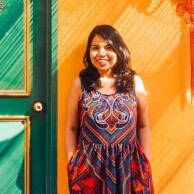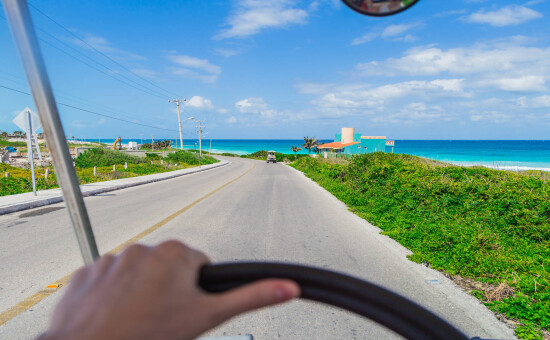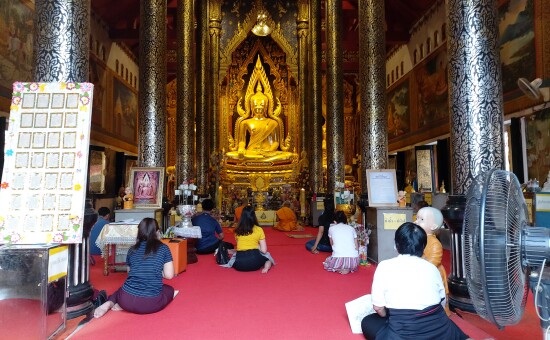5 fun Filipino fiestas you must experience
Take a peek into the world of Filipino fiestas and immerse in the local culture. Celebrate with the locals to experience the Philippines like never before.
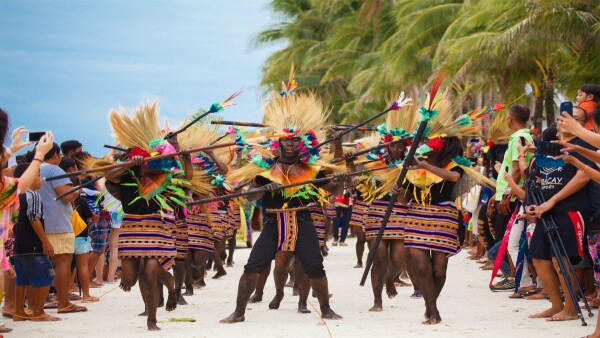
If you’ve met Filipinos anywhere in the world, you’ll know that they are a fun bunch of people to hang out with. They love to eat, dance, have fun and know how to turn every celebration into a massive party. With that knowledge in mind, it is not surprising that cultural fiestas are a big deal in the Philippines.
How exactly the tradition of celebrating fiestas came along is debatable, but it is mostly attributed to the Philippines’ Spanish colonial rule that lasted for more than 200 years. But whatever be the origin, what matters now is that they are an inseparable part of the Philippines’ cultural landscape.
But what exactly are fiestas? In the Philippines, fiestas are essentially a festival, typically dedicated to a patron saint, or sometimes meant to celebrate a particular season. But what’s unique about these celebrations is that the entire city comes out and participates in the events that go on all day long and sometimes even for weeks. There’s a free flow of food and drinks, dancing, music and a lot of fun in general.
But before we go on to tell you about some of the most famous fiestas in the Philippines, let us take you on a virtual experience of what to expect during a fiesta.
Food and drinks galore!
Not surprisingly, eating and drinking are a big part of any Filipino fiesta. Filipinos prepare nothing less than a feast and open up their homes to guests and practically anyone who wants to drop by for a festive meal at their home. The concept, known as an open house, is fairly popular in many Southeast Asian countries. Thus, it is easy to imagine Filipinos taking it a few notches higher when it comes to their annual celebrations!
One of the most common dishes prepared during a fiesta is the Lechon, a whole roasted pig, a universal festive delicacy in the Philippines. This is followed very closely by pork or chicken adobo, which is the unofficial national dish of the country. But more than the food items, it is the atmosphere of warmth and generosity that one experiences during a Filipino fiesta that leaves a lasting impression.
Dance the night away
If food is the soul of the Philippines’ fiestas, dancing is at the heart of it! The streets of the Philippines get taken over by locals as they parade the city in elaborate, colorful costumes, which differ from one festival to another. These celebrations are day-long affairs and it’s common for locals to visit different parts of the city to watch or participate in them.
However, despite being local cultural celebrations, these fiestas are extremely inclusive. Whether you are a local resident or a tourist passing through the city, everyone is equally welcome to take part in the festivities, especially the street dancing. If you’ve been wanting to truly immerse yourself in the local culture of the Philippines, there is no better way to do so than to get involved in one of these fiestas.
5 Filipino fiestas to experience all the fun
Now that you have an idea of what it’s like to be a part of a Filipino fiesta, here are five festivals we think are worth traveling for.
Sinulog
Dedicated to honoring and celebrating baby Jesus, also known as Santo Niño, Sinulog is the biggest fiesta to be celebrated in Cebu. Held every year on the third Sunday of January, the term Sinulog refers to the movement of water. It is also interesting to note here that the traditional dance performed at Sinulog resembles the movement of water currents – two steps in the front and one step in the back.
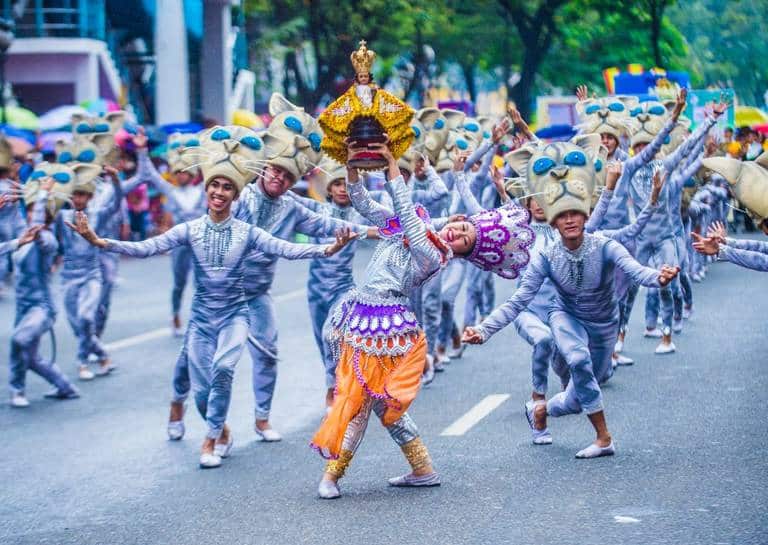
Marked by 3-day long street parties, parades, dancing, and raves, Sinulog attracts millions of people from all over the world and is definitely one of the most popular fiestas of Philippines.
Location: Cebu
Date: 3rd Sunday of January
Duration: Approximately 2 weeks
Ati-Atihan
Held every year in the month of January, Kalibo’s Ati-Atihan festival has tribal origins. It is said that the fiesta was first celebrated by the native Aetas tribe of the Philippines to welcome and provide refuge to members of the Bornean Datus tribe.
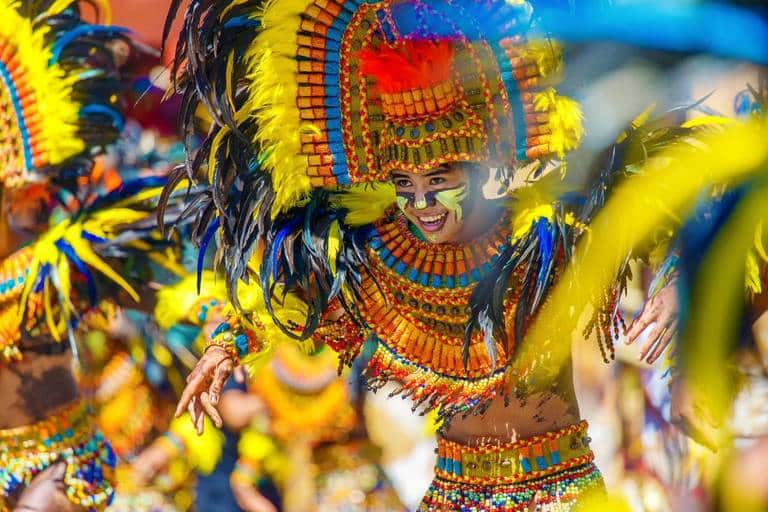
In return, the Datus provided food and shelter to the Aetas later during the time of famine, giving birth to the Ati-Atihan fiesta. Rumour has it that the Ati-Atihan became so popular as one of the biggest fiestas in the Philippines, it gave birth to similar festivals in other parts of the country, most notably the Sinulog festival in Cebu.
Location: Kalibo
Date: 3rd Sunday of January
Duration: 18 days
MassKara
Celebrated on the 4th Sunday every October, Masskara is a relatively new festival started in the 1980s, compared to others that go back hundreds of years. But what sets this festival apart is the use of decorative smiling face masks as part of the festival costume. The masks represent the undying spirit of Filipinos to fight every challenge that comes their way.
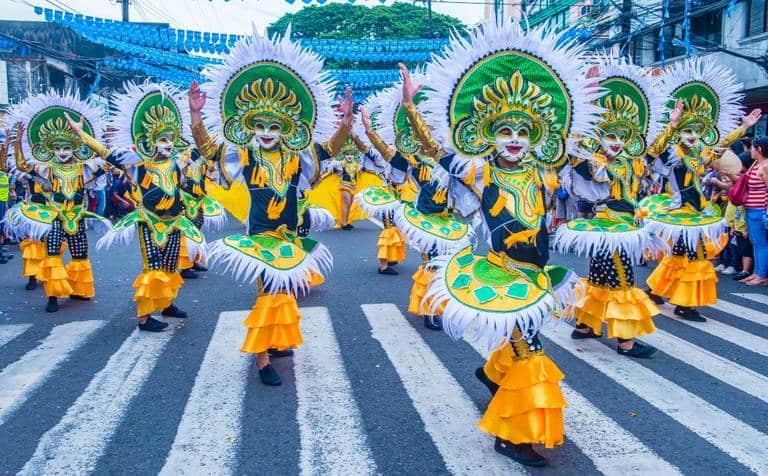
The usual street parades are also a part of Masskara along with fun competitions like pole climbing that are held to bring together people from all across the region.
Location: Bacolod
Date: 4th Sunday of October
Panagbenga
Sometimes referred to as the festival of flowers, and very rightly so, the term Panagbenga essentially means ‘season of blooming’. And what better way to bring in the festive spirit of Panagbenga than to celebrate with Baguio’s beautiful blossoms? The biggest highlight of this fiesta is the grand parade that goes through the entire city with participants dressed in floral themed costumes.
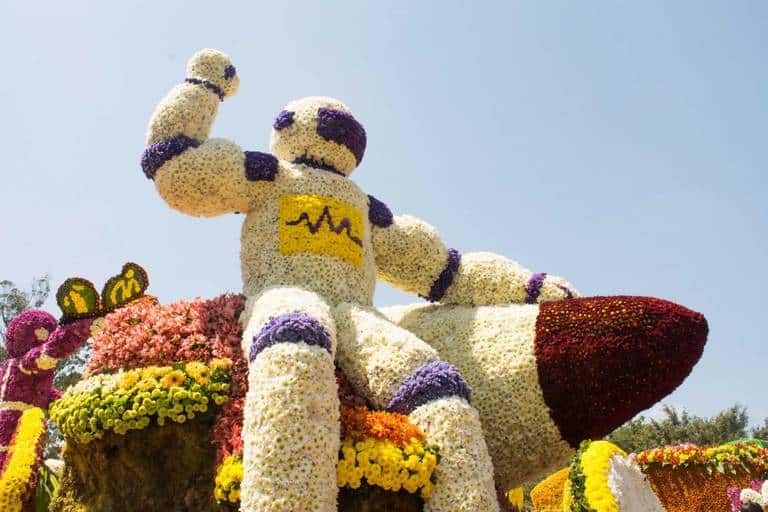
A real treat for the eyes, Panagbenga’s popularity is clearly evident in the sheer number of people that come here to witness the celebrations!
Location: Baguio
Date: Typically starts on the 1st of February
Duration: More than a month
Pahiyas
One of the most colorful fiestas in the Philippines, Pahiyas is a celebration of abundance. Dedicated to worshipping the patron saint of farmers, San Isidro de Labrador, the festival coincides with the local harvest season. Farmers decorate their homes in vibrant colors and the activity has a tinge of competitiveness to see whose house has the best decoration, all in the spirit of the festival.
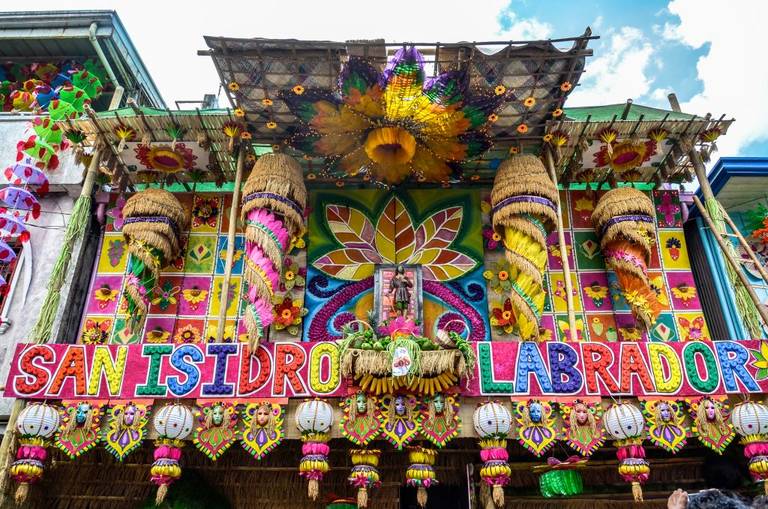
But apart from that, a huge draw of the Pahiyas festival is the display of a wide array of fresh fruits and vegetables everywhere in the city for visitors to savor, along with local rice cakes called Suman.
Location: Quezon
Date: 15th of May
Duration: One whole day
It is sometimes said that there is a fiesta for every month of the year in the Philippines. So no matter which time of the year you choose to visit the country, you are probably going to be able to participate in or at least witness one of them. But irrespective of which fiesta piques your interest, we hope that you get to experience this vibrant country in all its glory – uninhibited and unabashed!
FAQ
Flying is the fastest. Cebu Pacific and AirAsia are low-cost airlines.
Yes, and no. There are large parties everywhere, in all the major cities. Fireworks galore! However, there isn’t one special festival during that time.
Yes. As long as you are not in very rural areas, most people speak some English.

